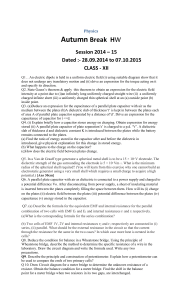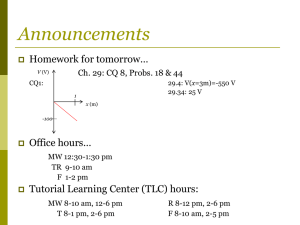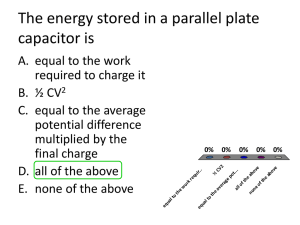five marks questions
advertisement
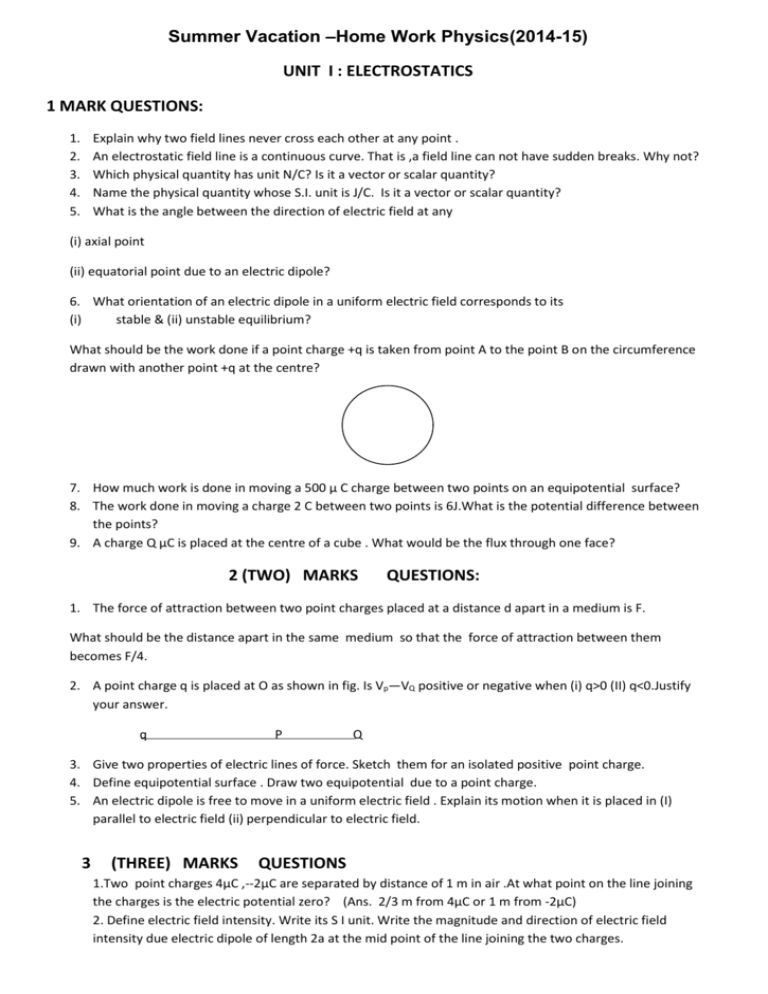
Summer Vacation –Home Work Physics(2014-15) UNIT I : ELECTROSTATICS 1 MARK QUESTIONS: 1. 2. 3. 4. 5. Explain why two field lines never cross each other at any point . An electrostatic field line is a continuous curve. That is ,a field line can not have sudden breaks. Why not? Which physical quantity has unit N/C? Is it a vector or scalar quantity? Name the physical quantity whose S.I. unit is J/C. Is it a vector or scalar quantity? What is the angle between the direction of electric field at any (i) axial point (ii) equatorial point due to an electric dipole? 6. What orientation of an electric dipole in a uniform electric field corresponds to its (i) stable & (ii) unstable equilibrium? What should be the work done if a point charge +q is taken from point A to the point B on the circumference drawn with another point +q at the centre? 7. How much work is done in moving a 500 µ C charge between two points on an equipotential surface? 8. The work done in moving a charge 2 C between two points is 6J.What is the potential difference between the points? 9. A charge Q µC is placed at the centre of a cube . What would be the flux through one face? 2 (TWO) MARKS QUESTIONS: 1. The force of attraction between two point charges placed at a distance d apart in a medium is F. What should be the distance apart in the same medium so that the force of attraction between them becomes F/4. 2. A point charge q is placed at O as shown in fig. Is Vp—VQ positive or negative when (i) q>0 (II) q<0.Justify your answer. q P Q 3. Give two properties of electric lines of force. Sketch them for an isolated positive point charge. 4. Define equipotential surface . Draw two equipotential due to a point charge. 5. An electric dipole is free to move in a uniform electric field . Explain its motion when it is placed in (I) parallel to electric field (ii) perpendicular to electric field. 3 (THREE) MARKS QUESTIONS 1.Two point charges 4µC ,--2µC are separated by distance of 1 m in air .At what point on the line joining the charges is the electric potential zero? (Ans. 2/3 m from 4µC or 1 m from -2µC) 2. Define electric field intensity. Write its S I unit. Write the magnitude and direction of electric field intensity due electric dipole of length 2a at the mid point of the line joining the two charges. 3. A parallel plate capacitor each with plate area A and separation d is charged to a potential difference V. The battery used to store charge is then disconnected. A dielectric slab of thickness d and dielectric constant is now placed between the plates. What change if any will take place in (I) charge on the plates (II) electric field intensity between the plates. (iii ) capacitance of the capacitor. Justify your answer in each case. 4. A parallel plate capacitor is charged by a battery and the battery remains connected, a dielectric slab is inserted in the space between the plates . Explain what changes if any , occur in the values of (I) potential difference between the plates (II) electric field between the plates (III) energy stored in the capacitor. 5.State Gauss”s Theorem in electrostatics. Using this theorem, find the electric field strength near an infinite plane sheet of charge. (FIVE MARKS QUESTIONS) 1. Briefly explain the principle of a capacitor . Derive an expression for the capacitance of a parallel plate capacitor, whose plates are separated by a dielectric medium. 2. Derive an expression for the energy stored in a parallel plate capacitor C, charged to a potential difference V . Hence derive an expression for the energy density of a capacitor. 3. Describe the construction and working of a Van de Graff generator with the help of a labeled diagram. Class - XII UNIT 2: CURRENT ELECTRICITY ONE MARK QUESTIONS Q1. A carbon resistor is marked in coloured bands of red, black, orange and silver. What is the resistance and tolerance value of the resistor? Q2. A physical quantity, associated with electric conductivity, has the SI unit ohm meter. Identify this physical quantity. Q3. Define electrical conductivity of a conductor and give its S.I. unit. Q4. Plot a graph showing the variation of resistivity of nichrome with temperature. Q5. When is a Wheatstone’s bridge most sensitive? TWO MARKS QUESTIONS Q1. Two metallic wires of the same materials have the same length but cross sectional area is in the ratio of 1:2. They are connected (i) in series and (ii) in parallel. Compare the drift velocities of electrons in the two wires in both the cases (i) and (ii). Q2. Derive an expression for the resistivity of a good conductor, in terms of the relaxation time of electrons .Q3. Explain how electron mobility changes from a good conductor (i) when temperature of the conductor is decreased at constant potential difference and (ii) applied potential difference is doubled at constant temperature. Q4.A cell of emf (E) and internal resistance (r) is connected across a variable external resistance (R) Plot graphs to show variation of (i) E with R (ii) terminal p.d. of the cell (V) with R. Q5. Two students X and Y perform an experiment on potentiometer separately using the circuit diagram shown here. Keeping other things unchanged (i) X increases the value of resistance R (ii) Y decreases the value of resistance S in the set up How would these changes affect the position of null point in each case and why? Q6. Potential difference across terminals of a cell were measured ( in volts ) against different currents ( in ampere ) flowing through the cell. A graph was drawn which was a straight line ABC. Using the data given in the graph determine, (i) the emf and (ii) the internal resistance of the cell. THREE MARKS QUESTIONS Q1. Prove that the current density of a metallic conductor is directly proportional to the drift speed of electrons. Q2. A conductor of length L is connected to a D.C. source of potential V. If the length of the conductor is tripled by stretching it, keeping V constant, explain how do the following factors vary in the conductor: (i) drift speed of electron (ii) resistance (iii) resistivity. Q3. In the metre bridge, the balance point is found to be at 39.5 cm from the end A, when the resistor Y is of 12.5 ohm. Determine the resistance of X. Why are the connections between resistors in a metre bridge made of thick copper strips ? What happens if the galvanometer and cell are interchanged at the balance point of the bridge? Would the galvanometer show any current? Q4. How does the resistivity of a conductor and a semiconductor vary with temperature? Give reasons for each case. Q5. A potential difference V is applied across the ends of copper wire of length L and diameter D. What is the effect on drift velocity of electrons if (i) V is doubled (ii) L is doubled (iii) D is doubled. CLASS : XII UNIT III : MAGNETIC EFFECT OF ELECTRIC CURRENT AND MAGNETISM Five Marks Questions : 1 Write an expression for force experienced by a charged particle moving in a uniform magnetic field ? With the help of labeled diagram, explain principle and working of a cyclotron. Show that cyclotron frequency does not depend upon the speed of particles. 2 State Ampere Circuital Law. Derive an expression for the magnetic field at a point due to straight current carrying conductor. Derive an expression for torque acting on a rectangular current carrying loop kept in a uniform magnetic field B. Indicate the direction of torque acting on the loop. 3 4 A straight thick long wire of uniform circular cross section of radius ‘a’ is carrying a steady current I. The current is uniformly distributed across the cross section. Using Ampere’s Circuital law calculate the magnetic field outside and inside the wire at a distance for (i) r > a (ii) r < a from the axis. What is the magnetic field at the surface of this wire? Plot the graph showing this variation.
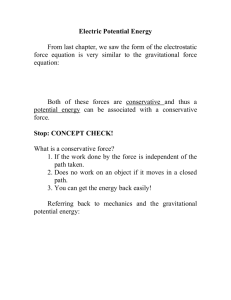
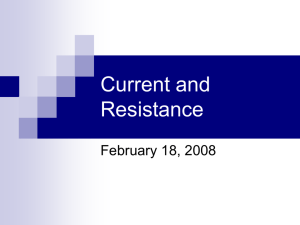
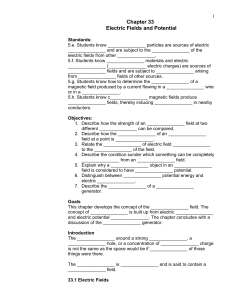
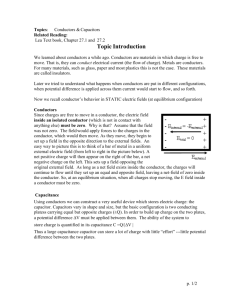

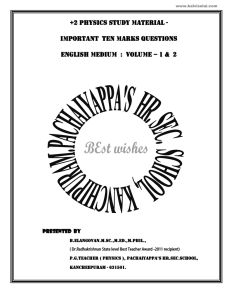
![Sample_hold[1]](http://s2.studylib.net/store/data/005360237_1-66a09447be9ffd6ace4f3f67c2fef5c7-300x300.png)
